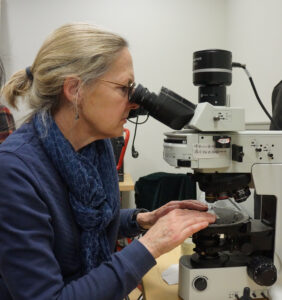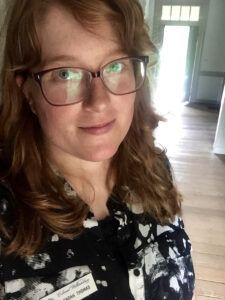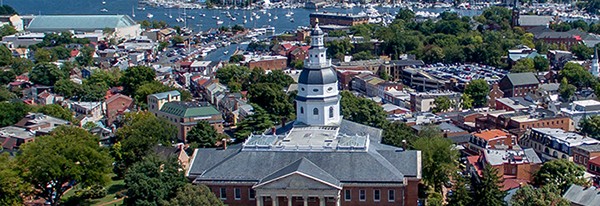The James Brice House is one of the largest and most elegant of Annapolis's historic homes, and one of the most important surviving structures from colonial America. Recognizing the importance of the architectural gem, the State of Maryland purchased the James Brice House in 2014 and arranged for Historic Annapolis, Inc. (HA) to maintain and manage the National Historic Landmark property.
In 2016, HA embarked on a multi-year, multi-million dollar restoration of the James Brice House. The experts HA has assembled for this project are highly respected in their fields, are known world-wide and have worked on the nation's most important historic structures including Mount Vernon, Monticello, Montpelier, Drayton Hall, and the Maryland State House.
HA invites you to visit the website, follow the restoration, and learn about the remarkable discoveries the experts are uncovering in the house.
The James Brice House: A Brief History
James Brice was a lawyer and planter, a local and county officeholder, a member of Maryland’s Executive Council for many years, and acting Governor in 1792. He and his wife, Juliana Jennings, had seven children. Thanks to Brice’s detailed account book, we know a lot about the construction of his five-part Georgian house, one of the largest and most elegant of Annapolis’s historic mansions. Work began on April 14, 1767 with the laying of a cornerstone marked “The Beginning.” Seven years, 326,000 bricks, and 90,800 cypress shingles later, the house was completed at a cost of just over £4,014 in colonial Maryland’s currency.
The house stayed in the Brice family until the 1870s, when it was purchased by the Martin family, and in 1911 it was bought by the proprietors of the nearby Carvel Hall Hotel. St. John’s College acquired the house in 1927 and converted it to faculty apartments. Stanley and Helen Wohl bought it in 1953 and restored it to single-family use. In 1979, the International Union of Bricklayers and Allied Craftsmen purchased the house (later known as the International Masonry Institute) and began using it for office and meeting facilities. Recognized as one of Maryland’s most important historic resources, the State of Maryland purchased the James Brice House in 2014 and arranged for Historic Annapolis, Inc. (HA) to maintain and manage the National Historic Landmark property.
A Unique Maryland Story
Historians today commend James Brice for the extraordinary accounts of the work he kept during the construction of the Brice House, built with the skill and discerning eye of a laboring class and with the aid of a talented but enslaved work force. The extent of the documentation for the Brice House is paralleled by few other colonial American endeavors, perhaps matched only by the overly obsessive record keeping of Thomas Jefferson at Monticello and by the meticulous writings of George Washington about his Mount Vernon estate. Although James Brice clearly had a hand in the design and construction oversight of his town dwelling, he appears more trusting of the tradesmen he selected to engage in his project than did his Virginia counterparts.
The building left by Brice and the handiwork of the workmen who erected it are extraordinarily intact. The house holds the potential to go beyond the traditional historic house museum to tell a greater story, which will emphasize both the contribution of those who toiled to make the structure what is was in 1774, and highlight the skills of a new generation of builders, conservators and technicians who will restore the house to its former glory. Nowhere else in Maryland can a similar story be told in such depth and richness as here at the James Brice House, and HA plans to do just that.
Scope of Work
HA intends to restore the James Brice House to its completed 1774 appearance. The result will be an academically sound, museum-grade restoration of the exterior and interior of the house implemented to the highest standards applied to traditional building restorations. Since the house retains most of its original fabric in the center block, much of the work beyond replacement of building systems will focus on a state-of-the-art restoration of finishes (plaster, paint, masonry, wood elements, etc.) and replacement of its few missing parts.
Once complete, the house will be open to the public for tours, preservation research, meeting space, educational programming, and exhibitions showcasing the building’s extraordinary architecture and history.
Meet the Team of Experts
Since June 2016, the following team of experts has been in place conducting historical investigations, primary source research, and architectural pre-design planning work. Their findings are providing critical information that will ensure the proper restoration of the James Brice House. They are highly respected in their fields, and Historic Annapolis is honored to have them working on this prestigious project.
William “Bill” Neudorfer, Zaras & Neudorfer Architects 
Bill Neudorfer is a partner at Zaras & Neudorfer Architects in Washington, DC. (founded in 1999). Bill has extensive experience working on demanding and complex historic architectural projects, including projects within the jurisdiction of the National Historic Landmarks Program, the National Register of Historic Places, and the DC Historic Preservation Office, just to name a few. Prior to ZNA, Bill worked as a Project Architect for Hartman-Cox Architects specializing in historic buildings in the Pennsylvania Avenue development corridor, and museum renovations including the Chrysler Museum, Dumbarton Oaks, and the Winterthur Museum. For the James Brice restoration project, Mr. Neudorfer is the lead architect responsible for completing the construction drawings, managing all consultants, and providing oversight to the general contractor.
Willie Graham, Consulting Architectural Historian
Willie Graham, having spent 35 years as Curator of Architecture for the Colonial Williamsburg Foundation, now serves as a consultant on a variety of public and private historic building projects. He undertakes and advises on the research, design, administration and interpretation of traditional buildings, archaeological sites and museums in America, the British Caribbean, Bermuda and Great Britain. Willie specializes in building analysis and recording, restoration and reconstruction of structures and landscapes, and consults on some of the nation’s most important historic sites, such as the State Houses in Maryland and South Carolina, Mount Vernon, Monticello, Montpelier, Ash Lawn-Highland, and a World Heritage site in Barbados. He is an accomplished architectural photographer and well-known in his field for creating new models and protocols for historic analysis. For the James Brice House restoration project, Mr. Graham is responsible for analyzing the building’s historic fabric, determining a restoration scheme, and providing design for missing elements. He also serves as the onsite advisor to the general contractor and subcontractors.
Matt Webster, Consulting Building Conservator
Matt Webster is the Director of the Grainger Department of Architectural Preservation for the Colonial Williamsburg Foundation where he is responsible for the preservation of 603 structures in the National Landmark Historic Area, as well as the 15,000-piece architectural fragment collection. Prior to Williamsburg, he served as Director of Preservation at Drayton Hall (1754) in Charleston, South Carolina and Director of Restoration for George Washington’s Fredericksburg Foundation in Fredericksburg, Virginia. He has consulted on projects throughout the eastern United States as well as internationally in Jamaica, Saint Vincent and the Grenadines, and Russia. He has taught at the University of Virginia and University of Mary Washington and lectures frequently on preservation, architecture, and history topics. For the James Brice House restoration project, Matt is advising on the conservation of original fabric and material acquisition. He is also assisting with the historic building analysis.
Susan Buck, Conservator and Paint Analyst
Susan Buck is a conservator and paint analyst in private practice. She completed her Ph.D. in Art Conservation Research at the University of Delaware in 2003 where she studied the decorative materials in the main house and outbuildings of the Aiken-Rhett House in Charleston, South Carolina for her dissertation. She teaches optical microscopy analysis in the Winterthur/University of Delaware Graduate Program in Art Conservation, where she received her MS, and in a new graduate conservation program for furniture and historic interiors in Beijing co-sponsored by the World Monuments Fund, The Palace Museum and Tsinghua University. Her private conservation work includes treatments, and paint and finish analysis for institutions including Mount Vernon, Monticello, Montpelier, The Metropolitan Museum of Art, Drayton Hall, Chipstone Foundation and the World Monuments Fund Qianlong Garden Conservation Project in The Forbidden City in Beijing. For the James Brice House restoration project, Ms. Buck is responsible for collecting and analyzing paint throughout the house, inside and out, for the purpose of understanding the paint and finish history and to determine the color, treatment, and character of the paints to be used in the restoration.
Sarah Thomas, Consulting Historian
Sarah Thomas, an historian of buildings and objects, is a Ph.D. candidate in History at the College of William & Mary and holds the Lemon Project fellowship this year. She has a Masters in Architectural History from the University of Virginia and a Masters in History from William and Mary. Sarah has worked at the Smithsonian National Museum of American History, Monticello's Gardens and Grounds Department, and Monticello’s Jefferson Library, and will continue her work this summer as an Architectural Research Associate at Colonial Williamsburg. She has received numerous research fellowships and has taught undergraduate courses at William and Mary on early American history and the history of colonial and Revolutionary-era Williamsburg. For the James Brice House, Ms. Thomas is responsible for transcribing the James Brice House ledger book, researching and identifying related primary source documents, as well as family ancestry and the provenance of specific objects.
Tyler Tate, Lewis Construction
In December 2016, HA hired Lewis Contractors to serve as the project’s general contractor. Lewis Contractors has an unsurpassed reputation for excellence in institutional construction and historic preservation. They have an impressive portfolio of award-winning projects for the most prominent owners and architects in the Baltimore/Washington area. Their expertise is as broad as it is deep, with a portfolio ranging from public and private educational work—spanning from lower schools to graduate research facilities—to healthcare and hospital construction, manufacturing lines, laboratory cleanrooms and places of worship. Their restoration work stands the test of time, with signature projects including the restoration of The Baltimore Basilica of the Assumption (America’s first Roman Catholic cathedral) and the restoration of the roof at Thomas Jefferson’s home at Monticello. Tyler Tate has been leading the company as President since 2013. He holds an MS, Civil Engineering, Summa Cum Laude (Geotechnical & Structural Focus) from Lehigh University and is a Professional Engineer (Civil Discipline) and LEED Accredited Professional.
Funding Needs
Although much of the main block is quite intact from its original construction, it nevertheless requires an extensive, multi-year commitment to unravel its secrets and to piece it back together. Using the recent restoration of the Old Senate Chamber in the Maryland State House as a model for preservation excellence, HA has embarked on a museum-grade, state-of-the-art restoration that accurately refines and recreates its missing pieces and finishes, while inserting the modern building systems that such a museum requires.
Preliminary estimates are being calculated. The exact cost will be determined once the historical investigation and architectural pre-design work has been completed and final construction drawings are in place.
The project is a public-private partnership that is being accomplished collaboratively between the State of Maryland and Historic Annapolis, who is in the quiet phase of a capital campaign that includes the James Brice House as one of its top funding priorities.


